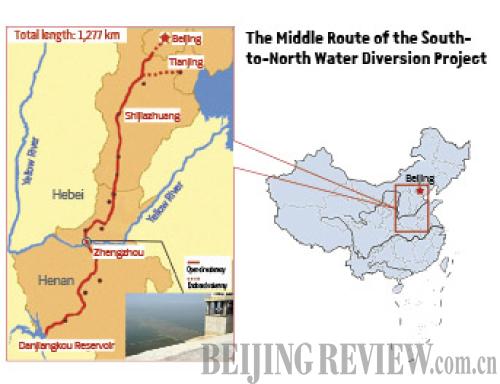|
Inspectors also found 15 enterprises from the 95 checked during the three-month campaign had discharged more pollutants into local rivers than allowed.
These companies have already received punishments such as fines and halt of production from local environmental departments, according to Wang.
Another challenge
Another concern has emerged along with the completion of the first phase of the SNWD project's middle route—whether or not the once-water-rich south has enough excess supply to help ease shortages in the arid north.
The worry was kindled after the Danjiangkou Reservoir, the water source used by the middle route, failed to store water as had been scheduled on account of a dry autumn season last year.
After eight years of construction, the height of a dam originally completed in 1973 has been raised by 14.6 meters, making it now 176.6 meters tall, so as to enable the Danjiangkou Reservoir to store up to 29 billion cubic meters of water. At full capacity, the reservoir has an area of 1,022 square km and is the second largest in China, surpassed only by the reservoir at the Three Gorges Reservoir on the upper reaches of the Yangtze River with a full capacity of 39.3 billion cubic meters.
The heightened dam passed quality checkups organized by the State Council in August 2013. Afterward, the reservoir was ordered to start storing water from the Hanjiang River, the largest tributary of the Yangtze River, during an expected autumn flood season in September and October.
The autumn flooding, did not come as expected however, as the Hanjiang River Basin, which stretches westward to Shaanxi Province, experienced a rainless autumn and many upstream dams had to hold more water to brace for potential severe winter and spring droughts.
As a result, the volume of water flowing down into the Danjiangkou Reservoir averaged just 446 cubic meters per second in September last year, down 70 percent from the average for that period annually.
Meanwhile, the reservoir was ordered to discharge no less than 800 cubic meters of water per second last September and no less than 600 cubic meters per second in the following October to meet demand in downstream of it. The gap drove water levels in the reservoir down by more than 3 meters over the two-month period, reducing the depth of the water in the reservoir to 144.15 meters, roughly 5 meters lower than its dead storage level.
The reservoir's water reserves were reduced to a historical low of 134.7 meters in May 2011 when areas of the country were hit by a once-in-a-century drought.
Historically, China's south has always been rich in water resources and often battled severe flooding while the north often suffered from severe water shortages. However, over the past couple of years, drought hit many regions in the south more frequently while the northern regions have begun to receive more rain.
In addition, rapid urbanization and robust economic growth along the Hanjiang River have boosted the local demand for water.
Wang Hao, Director of the Water Resources Department with the China Institute of Water Resources and Hydropower Research, suggests putting tributaries and reservoirs that lie upstream under the control of integrated water regulation so as to balance supply downstream to the Danjiangkou Reservoir.
Several water resources experts also propose that, with the authorities planning to increase the volume of water diverted from the Danjiangkou Reservoir to 13 billion cubic meters a year, building a canal to divert water from the Three Gorges Reservoir to supplement the Danjiangkou Reservoir should be considered.
Email us at: yinpumin@bjreview.com

| 